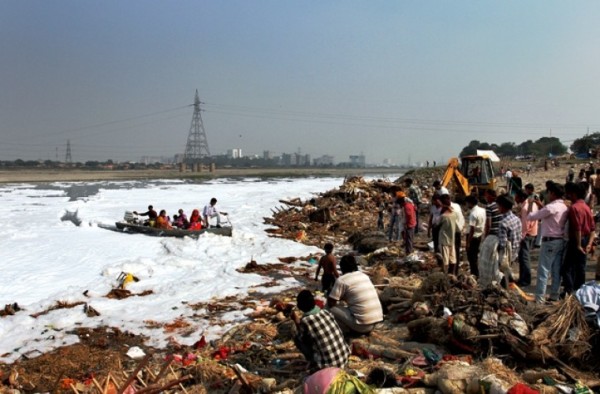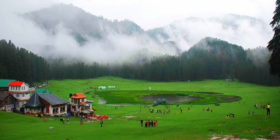Over Rs 1,500 crore spent, and not a drop to show. Atul Chaurasia travels 600 km along the Yamuna and finds the river dying at every bend.
AT MATHURA, countless songs fill the air regaling Lord Krishna’s relationship with hisgopis and the Yamuna. One look at the Yamuna today leaves one wondering whether there is anything left of the river of these songs. Instead, it is the masani nullah that catches the eye. “The Yamuna is mostly dry but masani flows the year round,” says Purshottam Yadav, who runs a tea stall near the riverbanks. Wherever it passes through, this is the fate of one of India’s oldest and holiest rivers.
Originating in the Yamunotri glacier in the Himalayas, the Yamuna flows 1,376 km before merging with the Ganga at Allahabad, Uttar Pradesh, to form the Sangam — one of the holiest Hindu pilgrimages. Our 600 km journey along the river looking for the place where we went wrong, starts at Dakpathar.
Forty-five kilometres from Uttarakhand’s capital Dehradun, Dakpathar is where the Yamuna leaves the secure Himalayas to enter the vast plains. In that sense, the Yamuna is luckier than the Ganga; it is shielded from pollution in the mountains longer than the Ganga. But, the pristine waters soon change colour.
Meandering through the Shivalik mountains, the Yamuna becomes an overflowing bowl of water after Dakpathar. This happens because the Tons river, Yamuna’s largest and longest tributary (holding more water than the main stream, merges with it).
The Yamuna also faces the first human intervention at Dakpathar. A canal meets the river about 20 km further downstream at Paonta Sahib. Not a single drop of water from the Tons enters the main stream of the Yamuna after Dakpathar as all the water is diverted to the canal. Three hydropower projects in quick succession lay claim on this stretch between Dakpathar and Paonta Sahib — Thakrani, Dhalipur and Kulhal.
These hydro-projects have caused havoc in the marine ecosystem of the river. Various kinds of fish like the katla, rohu and trout have disappeared without a trace. The large turtles, considered to be the Yamuna’s transport in Hindu mythology, are not seen anymore because they cannot swim upwards over these dams. There are also no records in government offices of the 500-odd fishing villages along the Yamuna that depended upon it for their livelihood during the 1970s. Even water birds that used to prey upon aquatic organism at the river’s estuary are not seen. Jitender, 27, sitting with a fishing line near the Yamuna after it comes out of Dakpathar puts it aptly: “There are no fish to be found here. If you catch some to eat, you’re lucky.”
The canal meets the Yamuna at Paonta Sahib, a sacred Sikh site in Himachal Pradesh to give it a new life. From Dakpathar to Paonta Sahib, the river flows between two states, with Himachal Pradesh on one side and Uttarakhand on the other. The Yamuna creates the state borders between the two states.
It is here that human excess and greed makes its appearance once gain. Trucks carrying stone and sand line up the riverbank. This is in open defiance of a Supreme Court order prohibiting mining in the river. Constant mining can have far-reaching consequences, some of them permanent. The river could even change its course.
Paonta Sahib is an industrial town with many factories and industries, including the Cement Corporation of India. All these industries are dependent on the Yamuna to some extent and are also responsible for some of its pollution. But the river can still handle these impurities.
ABOUT 25 km from Paonta Sahib, the Yamuna passes through the Kalesar National Bird Sanctuary and encounters the Hatnikund dam at Yamuna Nagar district in Haryana. This is also where the river starts dying a slow death. From this point, apart from the three monsoon months, not a single drop of water enters the Yamuna.
The water of the Yamuna is diverted into two canals — the Western Yamuna Canal and the Eastern Yamuna Canal. The Western Canal provides water for drinking and irrigation to half of Haryana; the other provides water to western Uttar Pradesh. This parting causes the main stream of the river to turn dry. “The Yamuna dies at Hatnikund,” says DD Basu, a senior official of the Central Pollution Control Board (CPCB). “Even if lakhs of treatment plants are installed, the river cannot survive only on sewer water.”
Surprisingly though, there is still some water when the river reaches Yamuna Nagar town. How is it possible, when no water passes Hatnikund? The answer lies at the place where the Yamuna enters the town. Right next to a sewage treatment plant of 10 MLD (million litres per day), two large sewers empty their waste into the river without any treatment. Walking along the river, there is not a single spot one can breathe properly because of the stench. This is the water that flows through the town that is ironically named after itself.
Further downstream, the Yamuna carries the waste of two more cities — Sonipat and Panipat — as it inches towards Delhi. Travelling about 200 km through mountains and plains, the Yamuna reaches Palla village in north Delhi. In the 22 km it flows through the city, the river dies 22 times.
THE RAVAGE begins at the Wazirabad plant, which drains out the remaining water from the river to quench the thirst of the city. To replace the water that is taken out, Delhi opens the Najafgarh drain into the Yamuna. This drain, along with 10 others, squeezes the life out of the river, as it keeps on accumulating waste and sewer along its path. As it leaves the city, the Shahdara drain empties itself into the Yamuna.
The extent to which Delhi pollutes the Yamuna can be gauged from the amount ofcoliform bacteria found in the river. These bacteria feed off human waste in water. Water contaminated with these bacteria can cause typhoid, cholera and kidney failure. According to a CPCB report, the percentage of coliform at Palla, where the river enters the city, is 30–1,000 times more than acceptable levels. Near the Okhla dam, after it has crossed the city, its levels are as high as 10,000 times more!
Several schemes to clean the drains through sewage treatment plants in the city have not yielded any results. The first Yamuna Action Plan was started in 1993 and 705.5 crore was spent on cleaning the river. Twenty years and 2,200 crore later, this plan remains a failure. The third phase is underway, and there is nothing to say things will be different this time. “The time period and the cost of such schemes are estimates,” says an official on condition of anonymity. “There is nothing wrong in them not meeting their targets.”
Says Nitya Jacob, programme director for water of the Centre for Science and Environment (CSE): “Delhi produces more than 445 crore litre of waste every day, of which only 147.8 crore litre is treated.”
The danger goes beyond water treatment. A research by The Energy and Resources Institute (TERI) found that the percentage of metals like nickel, lead, mercury and manganese are much higher than permissible limits in the vegetables grown along the banks of the river. These metals find their way to our dining tables and consequently our stomachs through these vegetables that we consume as “fresh”.
This is not all. Contrary to government claims, there are still about 200 factories manufacturing batteries in Delhi. Lakhs of two- and four-wheelers plying the roads of the city also contribute to the Yamuna’s pollution. There are almost 30,000 small and medium auto repair shops in the city. All the waste that comes from servicing these vehicles flows into the Yamuna. Although the CPCB has now woken up to this, they are still at a loss of how to deal with the crisis.
Modern lifestyle and migration have added to the river’s woes. Delhi needs electricity for the lakhs of refrigerators, air conditioners and room heaters that run in the city. For this, the three power stations — Rajghat, Indraprastha and Badarpur — burn coal to cater to the power need of Delhi. A report on arsenic pollution in the Yamuna prepared by the Geology Department of Delhi University says that all three thermal power plants dump a large portion of the residual ash and coal in the Yamuna. According to the report, the Rajghat Power Plant alone dumps 5.5 tonnes of arsenic in the Yamuna every year. Arsenic is a major cause for cancer and heart ailments. Tests on vegetables grown along the river bank in the Akshardham Mandir and Mayur Vihar Phase 1 area of east Delhi found arsenic levels as high as 135 parts per billion. The maximum limit for this is 10 parts per billion.
The study threw up a few interesting facts. The underground water of the city is only recharged by the river’s floodplains. When this underground water was tested, the level of arsenic in it was found to be 180 parts per billion.
As if this is not alarming enough, the Yamuna is growing shallower by the day. Experts believe that years of dumping waste into the river have caused it to change. Once famous for its depth, the Yamuna is now a pale shadow of its former self. During the monsoon, the water the river gets flows out, instead of recharging the underground reserves.
Moving away from Delhi, the Yamuna meets the Hindon river laden with all the waste the townships of Ghaziabad, Noida and Greater Noida have to offer.
At Mathura, the next halt of the Yamuna, themasani nullah flows into the river emptying more waste and the remains of the cremation ground it gets its name from. Industrial effluents also contribute to the plight of the Yamuna. Mathura has a flourishing dyeing industry and the colour and chemical waste gets washed down to the river. Besides, the city produces artificial jewellery made of nickel. Chemicals used in the manufacture, rubbing and polishing of the jewellery ultimately make their way into the Yamuna.
Ghats along the river greet the onlooker at Vrindavan. At Chir Ghat, 3 km from the ghats through a dust trail, a sewer line parallel to the river stream submerges into the river, as if to wash away its sins, much like the thousands of devotees taking a dip in the holy river. “Who can dirty Yamuna mata,” says a devotee. “Everyone becomes clean after taking a dip in it.”
Nothing changes when the river courses its way through Mahaban, where it is faced with the Gokul Barrage, and from there to Agra, the second largest city on its banks. A big drain, adjacent to the Yamuna Action Plan office, opens up into the river. At another place, 200 metres behind the Taj Mahal, another drain flows into the Yamuna. Dead carcasses lie strewn between the river and the Taj.
The city’s biggest dhobi ghat is Haatighat. Large furnaces have been put up to boil the river water for washing clothes. Afterwards, this water is thrown back into the river. “We have been washing clothes for generations,” says a washerman. “Find us some other place, we will move.”
Barely a stream now, the Yamuna flows on from Agra to its next stop — Bateshwar. Known for its temple bells, 80 km from Agra, the town has a row of temples in the middle of the river. From Bateshwar, the Yamuna courses its way through Etawah to merge with the Chambal river before going to Panchnada. The place gets its name from the confluence of five rivers — the Yamuna, Chambal, Kuwari, Sind and Pahuj. The water is clean here because of the four rivers that have merged with it to give it a fresh lease of life. The Chambal is the biggest among all four, and is considered to be one of the cleanest rivers in the country. However, that changes as soon as it comes in contact with the polluted waters of the Yamuna.
RENOWNED AROUND the world for its fresh water dolphins and the Indian ghariyal, found only in the Chambal, the river now faces a waning population of both species. In 2008, more than 100 ghariyal deaths were reported within two months. Renowned herpetologist Romulus Whitaker undertook a study to understand the cause of this catastrophe.
“All initial evidence pointed towards the Yamuna as the reason. We have turned this river into poison. Quite frankly, if the current situation persists, the days of ghariyals and river dolphins are numbered,” says Whitaker.
Tarun Nayar, executive officer of the Ghariyal Conservation Alliance, has prepared a report on the ghariyal deaths in the Chambal. “During 2008, a large number of ghariyals had made their nests within a 20 km radius of the spot where the Chambal meets the Yamuna,” says Nayar. “All ghariyal deaths have taken place in this stretch.”
Oblivious of the rampage it has created, the Yamuna moves along Bundelkhand until it reaches Allahabad, where it merges with the Ganga to become the Sangam at Prayag. Our journey is complete.
We have seen the Yamuna go from the most pristine of rivers to a toxic sludge. Can the Yamuna become what it was once? Can things be changed?
“Today, a person is evolved if he has running water in his tap and a flush in his bathroom,” says senior journalist Sopan Joshi, doing research on land, water and human waste. “The Yamuna could have been a goddess, but today it’s a toilet where there is no water to flush.”






Leave a reply